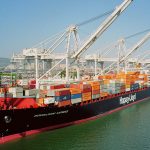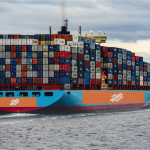Imports to Dramatically Slow in 2022
The Journal of Commerce (JOC) published a very interesting article by Larry Gross. Gross is president and founder of Gross Transportation Consulting and a JOC analyst. Despite the dramatic growth we’ve seen in cargo volume since the lockdowns and government stimuli helped nurture heavy increases in consumer spending – especially online shopping – Gross says when we look at 2021 versus 2020, we won’t actually see dramatic growth in imported cargo volume. That goes against what I’d say most in the international shipping industry have been assuming. Additionally, Gross says we can expect much slower growth in 2022 and beyond.
2021 Vs. 2020
I’ve been known to run counter to several – certainly not all – expert predictions about how cargo demand and the international shipping industry will perform. However, Gross’s predictions line up with the predictions I’ve been making over this last year much more than any expert analysis I’ve seen. He opens his article with:
While the current surge in import TEUs is of historic proportions, when the books are closed on 2021, the gains versus the prior year will not look nearly as strong, and will more closely resemble the gains seen in the year after the Great Recession.
The reason this runs counter to so many people’s thinking about 2020 versus 2021 is that in the first part of 2020, in the early days of the pandemic, there was actually a decrease in cargo volume. Fear struck the industry, as fear was pushed through society as a whole, with predictions that carriers would lose billions of dollars. Thus, carriers blanked (cancelled) sailings at a dizzying pace. Cargo volume never dropped as low as carriers expected, with them sinking capacity well below market demand; however, even as July hit, the rumor was that 2020 would have no peak season. I disagreed, predicting there would be a peak season, though I predicted lower-than-normal peak season volumes, saying, “It is unlikely volume numbers will be anywhere near as high as they would have been had the novel coronavirus pandemic not struck.” I was right about the former but very wrong about the latter.
2020 had an enormous peak season, and import cargo volume has remained at near-record to record levels ever since. With extremely high volume from the start of 2021, unlike the early parts of 2020, it makes sense that most in the industry would think 2021 would greatly outpace the previous year. Gross isn’t saying there won’t be growth seen in the numbers, only that growth won’t look nearly as strong as it would seem.
Why 2021 Might Not Be as Comparatively Big as We Thought
In my 3 predictions for the 2021 peak season, I said not only is the peak season going to be early this year but that it was likely already here (which seems to have turned out true with Universal Cargo’s numbers showing about a 27% jump in shipments last month and another 23% jump here in June). Along with that, I predicted we could see the peak season end early as well. The peak season ending a little early this year (if that prediction also comes true) paired with carriers having to blank many sailings during this current volume boom because of port congestion, failing to keep up with demand – as Greg Miller talks about in an American Shipper article – could contribute to less dramatic growth than expected. However, there’s much more than that happening.

Gross’s reference above to the Great Recession or the 2008 Recession is an apt one. Growth is expected, almost impossible to avoid, after a recession. However, the recovery in 2009 and beyond was incredibly slow, with job growth and unemployment numbers turning out to be not just lower than expected but abysmally so after President Obama took office. Sound familiar with reporters having to double check job growth numbers live on air because of how incredibly short April’s final job growth numbers fell of expectations here in President Biden’s first several months in office? When Louis Woodhill examined the data from the Great Recession’s recovery, comparing it to other recession recoveries, in a 2012 Forbes article, he concluded “Obama wins the gold for worst economic recovery ever.”
With very similar policy philosophies between the Obama and Biden administrations, we could easily be at the beginning of a similarly poor recovery. I’ve gone so far as to say in Universal Cargo’s blog that a crash in cargo volume is likely coming with all the businesses and jobs that have been lost to the lockdowns eventually catching up with us, incredibly high government spending that will factor into inflation (which we’re already seeing), further jobs lost and gas prices increased by President Biden’s attack on the oil industry with moves like cancelling the Keystone XL Pipeline, all while the administration pushes for higher taxes, more regulation, and more spending. These economic factors could have a very negative impact on recovery.
Gross’s Analysis – Current Recovery & the Great Recession’s
Gross expects recovery from the coronavirus-pandemic-caused recession to be similar to those of the 2008 Recession:
A review of past performance for the years after the big year of recovery suggests dramatically slower growth in the future. Further, there is good reason to expect that the gains this time will trail those we have previously seen.
Gross doesn’t give the “good reason” why this recovery should behave similarly to that from the Great Recession. Perhaps his reasoning is in line with whaat I wrote above or perhaps he has other reasons. Either way, Gross does lay out clear expectations with charts to illustrate what he’s saying. Here’s the analysis he gives:
The first chart examines the import TEUs arriving in the ports of the US and Western Canada since the start of 2017. It portrays the TEUs per working day received each month. This approach removes a substantial amount of month-to-month volatility, which is a statistical artifact resulting purely from calendar effects.
We can see that in August of 2020, import TEUs shifted into a higher gear than has previously been seen. Activity has subsequently been sustained at roughly the same level. As we compare this period with prior years, we can see that not only has volume been strong, but also unnaturally stable. You normally don’t get six months of activity remaining within such a narrow range. Only February showed much differential, and we can easily attribute that to the polar vortex and associated operational disruptions.
Such flat activity suggests that the system has been bumping into its capacity ceiling. Barring new capacity being brought online or major improvements in velocity, there is little reason to expect this situation will radically change in the coming months. This implies that year-on-year gains are going to shrink dramatically come August no matter how strong demand is.
As shown in the second chart, the first four months of 2021 have produced an outsized 27.8 percent gain versus the prior year, which dwarfs 2020’s pandemic-impacted volumes. The last nine months have been exceptional by any measure. The gain has been over 20 percent versus the prior year (third chart). But how meaningful is this?
In 2010, import TEUs climbed 17.1 percent for the full year as we recovered from the Great Recession downturn the previous year. Subsequent years showed gains of less than 5 percent. If we assume that import TEUs continue to arrive at the same rate that they were received in April, then for the year 2021, we will see a gain for the year of slightly over 15 percent versus 2020. Will history repeat?
From 2010 through 2019, the last “normal” year, import TEUs grew at a compound annual growth rate of 4.5 percent. Volume has grown faster than GDP as a result of continuing offshoring activity. Importantly, this differential implies the continuing flow of jobs overseas. Given the current tensions with China and the disruptions importers are currently dealing with, offshoring additional products and economic activity perhaps isn’t the “no-brainer” that it used to be.
If the situation simply stabilizes, then import TEU growth rates won’t exceed that seen in the goods portion of GDP. In other words, it doesn’t take “near-shoring” or “reshoring” to produce dramatically slower import growth. It simply requires an end to the flow of new activity overseas.
Caution is therefore indicated when looking at the durability of the current surge. Activity will likely be buoyed by continuing strong economic growth. But there is little reason to expect that the current torrid pace will continue as we move into 2022 and beyond.
Universal Cargo has no affiliation with the JOC nor do they pay us or in any way request endorsement, but articles like this one from Larry Gross make a subscription to the JOC worth it.





Excellent article! Keep em coming.